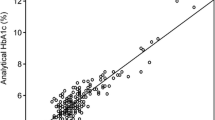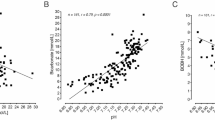Abstract
We aimed to compare the recent practical method of capillary β-hydroxy butyrate (βOHB) measurement with the widely used urinary ketone measurement in monitoring metabolic status of the patient during treatment of diabetic ketoacidosis (DKA) and diabetic ketosis (DK). Patients with DKA and DK admitted to the hospital were followed with simultaneous measurements of capillary βOHB by electrochemical method (Medisense Optium, Abbott), and urinary ketone by semi-quantitative method. Blood gases were measured in 2–4 h intervals. Fourteen patients with DKA/DK (7 males and 7 females, age: 9.2 ± 4.2 years) were included with 50 simultaneous measurements of capillary and urinary ketone. No correlation was detected between urinary ketone and blood pH (P = 0.06) and HCO3 (P = 0.79), whereas a significant negative correlation was found between capillary βOHB and blood pH (r = −0.41, P < 0.05) and HCO3 (r = −0.35, P < 0.05). Capillary βOHB and urinary ketone levels did not correlate at the beginning and 3.3 ± 1.4 h after treatment, but did correlate in the third samples taken 7.8 ± 2.0 h after treatment (r = 0.8, P < 0.05). Capillary βOHB levels show good correlation with the degree of acidosis (pH and HCO3). Capillary βOHB measurement is more sensitive than urinary ketone measurement in reflecting the patient’s metabolic status and improvement during treatment.

Similar content being viewed by others
References
Wildenhoff KE (1977) Tubular reabsorption and urinary excretion of acetoacetate and 3-hydroxybutyrate in normal subjects and juvenile diabetics. Acta Med Scand 201:63–67
Owen OE, Trapp VE, Skutches CL, Mozzoli MA, Hoeldtke RD, Boden G, Reichard GA Jr (1982) Acetone metabolism during diabetic ketoacidosis. Diabetes 31:242–248
Vanelli M, Chiari G, Capuano C, Iovane B, Bernardini A, Giacalone T (2003) The direct measurement of 3-beta-hydroxy butyrate enhances the management of diabetic ketoacidosis in children and reduces time and costs of treatment. Diabetes Nutr Metab 16:312–316
Harano Y, Suzuki M, Kojima H, Kashiwagi A, Hidaka H, Shigeta Y (1984) Development of paper-strip test for 3-hydroxybutyrate and its clinical application. Diabetes Care 7:481–485
McBride MO, Smye M, Nesbitt GS, Hadden DR (1991) Bedside blood ketone body monitoring. Diabet Med 8:688–690
Guerci B, Benichou M, Floriot M, Bohme P, Fougnot S, Franck P, Drouin P (2003) Accuracy of an electrochemical sensor for measuring capillary blood ketones by fingerstick samples during metabolic deterioration after continuous subcutaneous insulin infusion interruption in type 1 diabetic patients. Diabetes Care 26:1137–1141
Wallace TM, Meston NM, Gardner SG, Matthews DR (2001) The hospital and home use of a 30-second hand-held blood ketone meter: guidelines for clinical practice. Diabet Med 18:640–645
Harris S, Ng R, Syed H, Hillson R (2005) Near patient blood ketone measurement and their utility in predicting diabetic ketoacidosis. Diabet Med 22:221–224
Rewers A, MacFann K, Chase HP (2006) Bedside mentoring of blood beta-hydroxybutyrate levels in the management of diabetic ketoacidosis in children. Diabetes Technol Ther 8:671–676
Ham MR, Okada P, White PC (2004) Bedside ketone determination in diabetic children with hyperglycemia and ketosis in the acute care setting. Pediatr Diabetes 5:39–43
Author information
Authors and Affiliations
Corresponding author
Rights and permissions
About this article
Cite this article
Turan, S., Omar, A. & Bereket, A. Comparison of capillary blood ketone measurement by electrochemical method and urinary ketone in treatment of diabetic ketosis and ketoacidosis in children. Acta Diabetol 45, 83–85 (2008). https://doi.org/10.1007/s00592-008-0026-y
Received:
Accepted:
Published:
Issue Date:
DOI: https://doi.org/10.1007/s00592-008-0026-y




